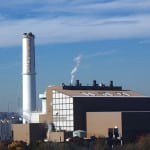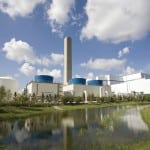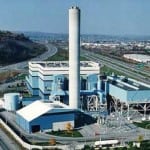Burning garbage to make electricity, or waste-to-energy, faces headwinds in the U.S., with low electricity prices, slowing demand for power, and local opponents that want to close or have closed plants. But a case remains for the least well-known renewable energy technology.
Travelers on a stretch of I-95 near Baltimore, Maryland, have long seen a prominent landmark: a tall smokestack with BALTIMORE in bold letters up the top third of the stack, sitting alongside a large industrial building. It is a waste-to-energy (WTE) plant, owned and operated by Wheelabrator Technologies.
The plant has been turning 2,250 tons per day of waste—material that would otherwise go to a landfill—into electricity for the local grid since 1985. It can generate 64 MW of power, which is sold to Baltimore Gas and Electric.
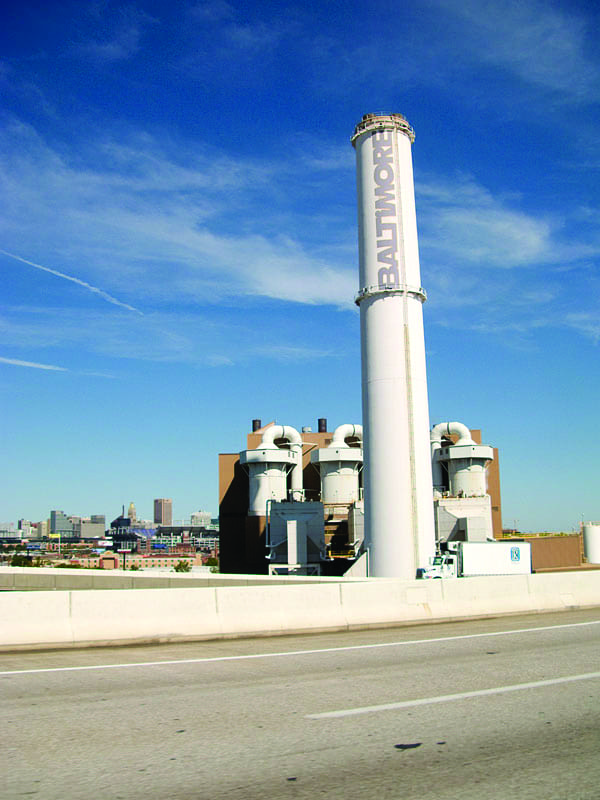 |
|
1. The iconic smokestack of the Wheelabrator Baltimore waste-to-energy (WTE) plant has been part of the city’s skyline for more than 30 years. Environmentalists have pressured state lawmakers to close the facility, or at least take away its designation as a provider of renewable energy. Source: Creative Commons / mikemccaffrey |
Wheelabrator may soon abandon the plant (Figure 1), perhaps demolish it. Pushed by environmental groups in the city and the Washington, D.C.-based Energy Justice Network, the city council in February passed legislation requiring continuous air monitoring at the WTE facility, and reductions in conventional air pollutants in 2020. That will increase the plant’s operating costs, part of the intent of environmentalists who want the plant to close.
[Ed. update (6/18/2019): According to a Wheelabrator representative, the city ordinance in question “requires air emission monitoring equipment that does not exist and imposes air emission criteria that are arbitrarily low.” As a result, the company has filed suit against the city, arguing the ordinance is unlawful. Wheelabrator issued the following statement at the time it filed the lawsuit:
“We, together with the National Waste & Recycling Association, the Energy Recovery Council, Curtis Bay Energy LP, and a small Baltimore-based waste hauler, are challenging the City ordinance in federal court as unlawful. Under federal and state law, the City does not have the authority to infringe on an area—air quality—already fully protected by federal and state laws, regulations, permits, and enforcement programs. The City’s ordinance, which will cost local taxpayers tens of millions of dollars, sets arbitrary standards. In contrast, the existing stringent limits in federal and state regulations are based upon evidence-based scientific studies that aggressively protect public health and the environment by requiring installation and operation of the best available pollution control technologies. Even more unreasonable are the requirements in the City law to install emissions monitoring technology that does not exist. We are confident we will prevail in court.”
See WHEELABRATOR BALTIMORE, L.P., et al. v. MAYOR AND CITY COUNCIL OF BALTIMORE, for more information.]
Maryland’s General Assembly also has taken aim at Wheelabrator Baltimore. The state Senate in 2018 and again this April passed legislation to strip the plant of its “green energy” designation in Maryland’s renewable portfolio standard, a label which provides Wheelabrator with subsidies and counts toward the state’s renewable target of 50% by 2030. Those measures died in the House of Delegates.
The U.S. Environmental Protection Agency (EPA) has long included waste-to-energy on its list of renewable energy technologies. The fuel is essentially inexhaustible. The EPA and the Department of Energy’s National Renewable Energy Laboratory in Golden, Colorado, have also shown that while WTE plants produce carbon dioxide from burning waste, they offset even more greenhouse gas (GHG) emissions from landfill methane.
Wheelabrator has argued that while its plant is the largest stationary source of air pollution in the city, its air emissions are dwarfed by motor vehicles, which produce 10 time the emissions of the incinerator. “Waste-to-energy is widely recognized as renewable, sustainable energy and should remain as such by statute,” said Jim Connolly, Wheeabrator Baltimore vice president, in a statement.
As events unfolded in Baltimore this spring, Detroit Renewable Energy (DRE) announced it will shutter its Detroit Renewable Power subsidiary. That WTE project has processed 3,300 tons of municipal solid waste (MSW) per day since 1991 into a refuse-derived fuel that is burned to produce 720,000 pounds of steam per hour. Some of that goes through steam turbine generators to make 68 MW of electricity. The remainder goes to Detroit Thermal, the city’s district heating and cooling business of more than 140 buildings in downtown and midtown Detroit. DTE Energy buys the electricity.
DRE will continue to provide steam to the district heating and cooling system, using natural gas as the fuel. DRE CEO Todd Grzech said in a statement: “Ceasing operations at the waste-to-energy plant gives us the ability to focus more on Detroit Thermal infrastructure, improving the condition of the underground steam system and the streets.” The company said it will work with its local union to find jobs and training for 150 workers displaced by the shutdown.
The closure came amid pressure from Breathe Free Detroit Campaign, a local environmental justice group. The group issued a statement: “We will continue to pursue environmental justice with our goals of protections for the workers and residents and working toward serious reducing, reusing and recycling efforts to produce zero waste.”
Are these developments in Detroit and Baltimore signaling a trend in the fortunes of the WTE business? Not according to Ted Michaels, head of the Energy Resource Council (ERC), the industry’s Washington-based lobbying group. He told POWER, “They are very local phenomena.” He noted that the WTE business faces challenges, but they are broader than what has occurred in Detroit and Baltimore.
More troubling are low prices for electricity across the U.S., driven by slow demand growth for power and low-cost natural gas, and the continuing availability of cheap landfills (which compete with WTE for the waste stream). Electric “market prices are at historic lows, and landfills are still relatively cheap,” Michaels said. “Our industry is strong. The facilities operate well; it’s a mature, not nascent, industry. But the industry is operating in difficult economic circumstances.”
WTE: A Niche Electric Market
According to the U.S. Energy Information Administration (EIA), the U.S. in 2016 had 71 WTE plants generating electricity in 20 states, with a total generating capacity of 2.3 GW. Florida was the leader, with “more than one-fifth of the nation’s WTE electricity generation capacity.” In 2015, the 95-MW Palm Beach Renewable Energy Facility 2 (a POWER Top Plant in 2016) became the first new WTE plant to come online since 1995 and the largest single WTE generator in the U.S.
Some generating capacity has been added to existing plants since Palm Beach came online, notes the EIA. WTE lobbyist Michaels said expanding existing plants is the best hope for U.S. industry growth in the short term.
WTE plants account for a tiny slice of total U.S. electricity capacity and generation, or about 0.4% of 2015 generation. Florida and four Northeastern states “accounted for 61% of the total WTE power plant capacity in the United States,” said EIA, “and they produced 64% of total WTE electricity generation.”
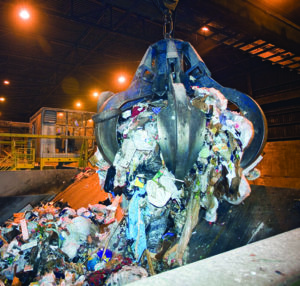 |
|
2. Florida leads the U.S. in WTE production, with more than 20% of the nation’s generation capacity, according to the EIA. The Buckingham Resource Recovery Facility operates in Fort Myers, Florida, turning trash into electricity. Courtesy: Lee County Government |
WTE plants turn the combustible content of MSW to energy, capturing and recycling metals and other noncombustible waste (Figure 2). MSW—aka garbage—contains biomass, or “biogenic” materials such as paper, cardboard, food waste, grass clippings, leaves, wood, and leather, and non-biogenics such as plastics, metals, and petroleum-based materials. According to the EIA, “The biogenic component of MSW makes up about 59% of total tonnage, but because of a lower heat content … it accounts for about half of the total net electricity generation.”
WTE is primarily driven by MSW management needs; electricity generation is secondary. According to Michaels, about 60% of revenue from a WTE plant comes from solid waste management and 40% from electricity generation.
Burning waste reduces its volume by about 87%, leaving mostly ash from air pollution control systems, and from the combustible and non-combustible materials. Based on the EPA’s 2013 figures, the U.S. produced some 254 million tons of MSW. The EIA calculates that WTE plants burned about 29 million tons of municipal waste in 2015, and 26 million tons were used to generate power. The remainder was recycled, composted, or landfilled.
WTE’s Boom Years
WTE had a 15-year heyday, driven in part by the 1978 Public Utility Regulatory Policies Act (PURPA). The law essentially created the non-utility generating industry. Prior to that seminal law, the conventional view was that generating electricity was a natural monopoly, best left to integrated, monopoly electric utilities and public power systems. About the same time, costs of landfills began escalating, while many municipal governments faced rising protests from citizens about the environmental impacts of landfills.
Many local governments had long incinerated garbage to reduce volumes flowing to landfills, but that provoked public opposition due to air pollution. With PURPA, developers began seeing a way to incinerate garbage in a technologically and environmentally sound fashion, generate electricity, and use the new law to force electric utilities to, reluctantly, buy the output.
According to the EIA, 90% of current WTE generating capacity developed between 1980 and 1995. In the 1990s, the EIA said, “as the mercury and dioxin emissions implications associated with combusting MSW began to be recognized, most existing facilities had to install air pollution control systems or be shut down, and the construction of new MSW-fired electric generation capacity came to a halt.”
Environmental opponents of new WTE projects also raised concerns about the toxicity of the ash being produced, though the EPA demonstrated that the ash was not a health problem.
What’s Ahead for Waste-to-Energy?
A solid case for WTE remains, although it isn’t getting the attention of opponents of the technology. Here’s the argument of the ERC:
- ■ WTE is renewable because garbage “is sustainable and non-depletable.” The American Recovery and Reinvestment Act (the Obama administration’s economic stimulus bill), the Energy Policy Act of 2005, the Federal Power Act, PURPA, the Biomass Research and Development Act of 2000, Federal Energy Regulatory Commission’s regulations, 31 states, two territories, and the District of Columbia all recognize WTE as renewable.
- ■ WTE “does not compete with recycling.” ERC said that communities with WTE facilities have an average recycling rate higher than the national average. WTE plants annually recover for recycling more than 730,000 tons of ferrous metals on-site.
■ WTE reduces GHGs. “Every ton of MSW processed by WTE facilities reduces 1 ton of GHGs (in CO2 equivalents). Recognized internationally as a GHG mitigating technology, WTE avoids methane that would have been generated if landfilled.”
- ■ Modern WTE facilities meet or exceed the EPA’s Maximum Achievable Control Technology standards for air emissions.
- ■ The ash is safe. Ash residue from WTE facilities is tested in accordance with strict state and federal leaching tests and is consistently shown to be safe for land disposal and reuse.
Nonetheless, the WTE industry is struggling, with new plants not on the horizon and political pressure on some existing facilities, as Baltimore and Detroit demonstrate.
What does the future hold for WTE in the U.S.? In the short term, increasing capacity at existing plants looks positive, Michaels noted, citing the “incredibly high reliability” and resilience of the current plants. “Events that bring down other plants don’t affect” the WTE facilities. They also have a good safety record.
But when it comes to new plants, that looks unlikely in the short term. The mid-term horizon could offer better prospects. “Policy has a big impact,” said Michaels, noting the role PURPA played in the 1980s and 1990s. Since then, PURPA has become largely irrelevant, as wholesale competitive markets and the overall downturn in energy prices have eroded the electric revenue side of WTE.
That could change. The federal government could enact a national renewable portfolio standard that includes WTE, or could put a program in place that administratively regulates CO 2 emissions. “Those could have a meaningful impact,” said Michaels.
In the meantime, the firms in the WTE business are pursuing overseas markets “very aggressively,” he said. ■
—Kennedy Maize is a long-time energy journalist and a frequent contributor to POWER.







